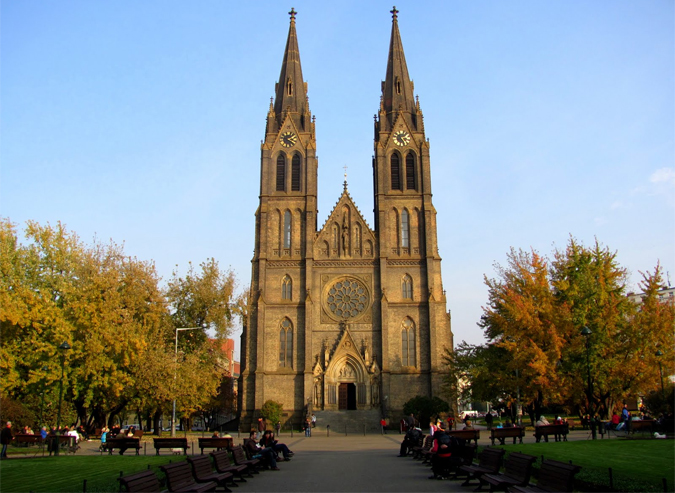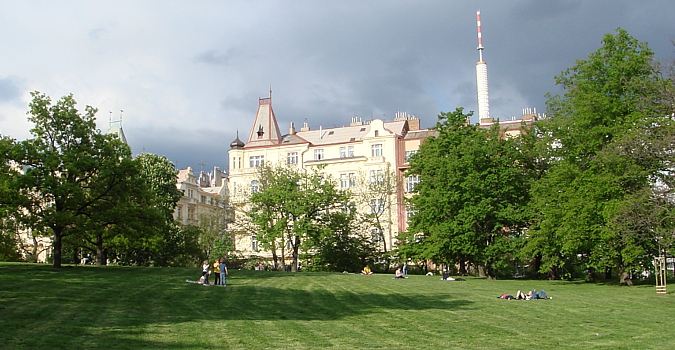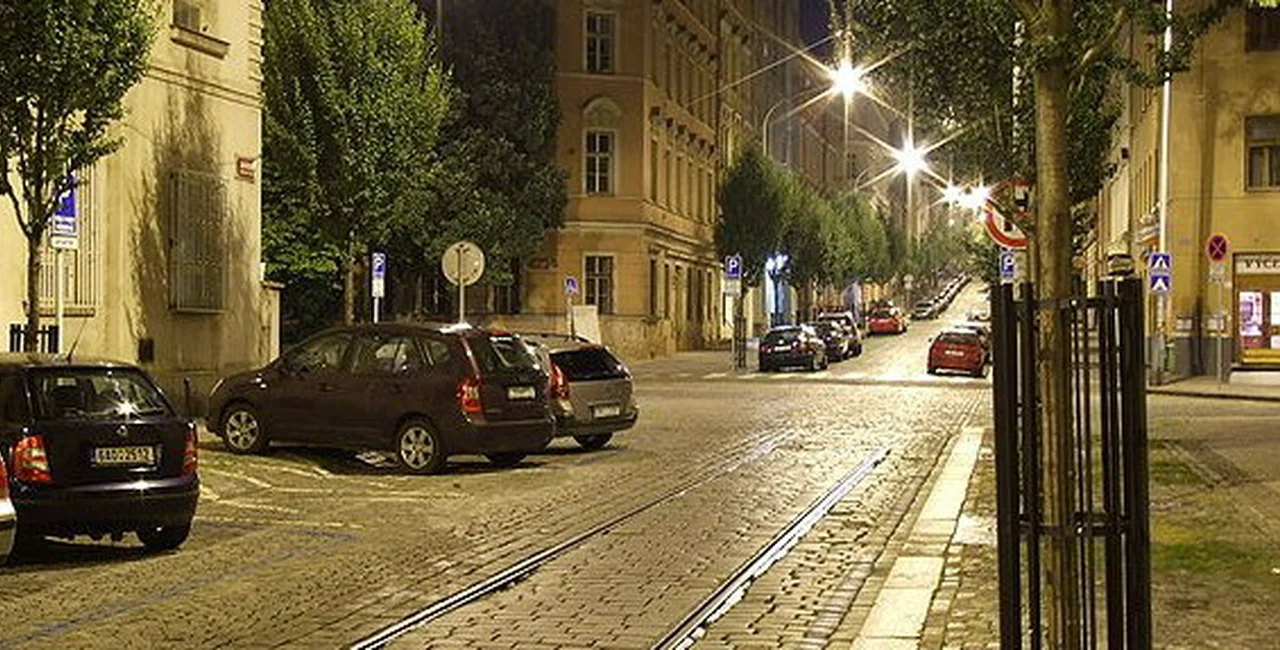Introduction
Of all Prague’s districts, Vinohrady is perhaps most associated with Prague’s foreign resident population. In fact, it could be regarded as the expat quarter par excellence. It’s not difficult to see why. High-quality housing, accessibility to the city center, attractive parks, a good selection of restaurants, and good facilities all make Vinohrady consistently popular among foreign residents.
Location
Although regarded as synonymous with Prague 2, Vinohrady also covers part of Prague 3 and Prague 10. The neighborhood begins just behind the National Museum on Wenceslas Square and extends eastwards, roughly ending around Želivského metro station. To the south, Vinohrady shares boundaries with Nusle and Vršovice, and Žižkov lies to the north.
Vinohradská is the main thoroughfare of Vinohrady, a lively, bustling high street running east/west, and Korunní, another main avenue, runs parallel to Vinohradská. Francouzská, also aligned roughly east/west, connects Vinohrady with Vršovice. Belěhradská is the main route south and starts where Vinohrady ends, and links Vinohrady with Nusle and beyond.
The focal point of the neighborhood is Náměstí míru, a significant public space, under the twin spires of the Neo-Gothic St Ludmila’s church. Events such as Christmas markets are held on the square, which is also an important transport node and the location of one of Prague’s most prestigious theaters. In addition, a number of decent restaurants are located on or close to Náměstí míru.

Náměstí Míru
History
Even if you don’t know much about the history of Vinohrady, the name itself offers a very strong clue. Vinohrady, as you probably guessed, means “vineyards”, which were established in the 14th century and once covered the area.
In fact Vinohrady only got its name in 1867; before then it was called Viničné hory, which also alludes to the vineyards. The area remained undeveloped until the mid-19th century, when Prague burgeoned and burst beyond the old city walls. Rows and rows of upscale tenements in ornate historicist styles sprang up around Náměstí míru, the heart of the emerging new quarter, which soon became synonymous with bourgeois good living. Vinohrady kept growing into the early 20th century, spreading eastwards. In the days of the First Czechoslovak Republic, Vinohrady continued to flourish, and slightly less grand but still highly desirable apartments were constructed in the Flora sub-district and in the some of the streets bordering Žižkov. The district became part of Prague as late as 1922.
Vinohrady’s solidly bourgeois ethos was severely compromised by the communist authorities, who were inevitably scornful of such an upscale district and regarded it as politically unreliable. A general neglect blighted the district’s ageing apartments, although compared to residents living in paneláks, Vinohrady’s inhabitants were relatively lucky.
The neighborhood’s fortunes reversed in the aftermath of the Velvet Revolution, as Vinohrady once again became one of Prague’s property hotspots in the 1990s. Investors, many of them foreign, poured millions of crowns into renovating properties that had real potential despite years of neglect. Expats poured in too, attracted by among other things, high quality housing and easy access to the center. Not surprisingly Vinohrady remains popular with foreigners today.

Riegrovy sady
Getting there and around
Like Žižkov, Vinohrady is very accessible, and much of the neighborhood is within walking distance of the city center. Commuting by tram or metro to the center should take no more than 20 minutes, even at peak hours.
In terms of public transport, the metro and trams are most convenient way of getting to Vinohrady. Metro line A runs through the area, with stops at Náměstí míru, Flora and Želivského; line C stops at I. P. Pavlova. Muzeum, just beyond the Vinohrady boundaries, is where the two lines meet. Tram routes 10, 11 and 16 pass through Vinohrady as they head east, and numbers 4 and 22 run from Vinohrady down into Vršovice. Tram number 5 passes through Žižkov and 5 terminates at Flora, and number 6 skirts the edge of Vinohrady en route to Vřsovice. Night tram numbers 51, 59 and 59 run through Náměstí míru; number 51 operates east along Vinohradská, and the other two routes run southeast. Route number 56 runs towards Nusle from I. P. Pavlova.
Buses services in Vinohrady are more limited, although number 135, which links Náměstí míru and Florenc via the southern edge of Vinohrady, is a useful route. Night buses only pass through the edge of Vinohrady, on north/south routes via I. P. Pavlova.
Environment
Vinohrady may be one of Prague’s most well-to-do areas but residents complain of dog fouling and graffiti, and air quality is not always the best. Some expats noted that they found Vinohrady, particularly the eastern edges, rather dusty.
Green space
The main green space in Vinohrady is Riegrovy sady, not far from the downtown end of Vinohradská and between the summit of Žižkov and the railway tracks at the main station. The park is well known to many expats thanks to the Park Café, comprising a beer garden and indoor restaurant. Riegrovy sady is also a favored spot for joggers, dogwalkers and frisbee enthusiasts among others. Other, smaller parks include Sady Svatopluka Čecha and Bezručovy sady.
On the other side of Vinohrady, Havlíčkovy sady, bordering Vršovice, is a popular spot (see Vršovice part I).
Housing
Vinohrady is a district of apartments, the vast majority of which date from the mid 19th century to the first three decades of the 20th century. Property prices are generally among the highest in Prague, reflecting Vinohrady’s popularity with locals and expats alike. Although apartments predominate in this part of town, around Dykova and Hradešínská, in the Prague 10 part of Vinohrady, you’ll a find a cluster of interwar villas.
In the oldest part of Vinohrady, around Náměstí míru, housing consists of apartments in tenements built before the First World War. Properties are of consistently good quality and most have three or more – usually generously sized – rooms. These apartments often retain original features such as plaster ceilings or original doors. Further east, around Flora, the housing stock is more modern, built in the 1920s and 30s, but the apartments are of good quality and still within easy reach of the city center.
Most of the housing stock in Vinohrady has undergone some form of renovation in the last two decades, some of it of a very high standard, which has helped cement the district’s reputation as one of Prague’s best neighborhoods.
SUMMARY
Strengths
• Excellent location close to the center
• High quality housing stock and villa quarter
• Excellent public transport links
• Attractive green spaces
Weaknesses
• Property very expensive
• Noise and traffic fumes is an issue on main roads
• Lack of off-street parking
Part II of this article looks at other aspects of life in Vinohrady including restaurants, shopping, sport, and culture.
***
OTHER PRAGUE DISTRICTS:












 Reading time: 5 minutes
Reading time: 5 minutes 






















